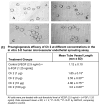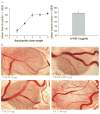Synthetic oligosaccharide stimulates and stabilizes angiogenesis: structure-function relationships and potential mechanisms
- PMID: 16954815
- PMCID: PMC4140568
- DOI: 10.1097/01.fjc.0000238591.90062.62
Synthetic oligosaccharide stimulates and stabilizes angiogenesis: structure-function relationships and potential mechanisms
Erratum in
-
Synthetic Oligosaccharide Stimulates and Stabilizes Angiogenesis: Structure-Function Relationships and Potential Mechanisms: Erratum.J Cardiovasc Pharmacol. 2022 Oct 1;80(4):629. doi: 10.1097/FJC.0000000000001371. J Cardiovasc Pharmacol. 2022. PMID: 36201458 No abstract available.
Abstract
To determine the proangiogenesis effect of series of saccharides and a synthetic oligosaccharide and potential mechanisms, an in vitro 3-dimensional endothelial cell sprouting (3D-ECS) assay and the chick chorioallantoic membrane (CAM) model were used. We demonstrated that a sulfated oligosaccharide significantly promotes the endothelial capillary network initiated by vascular endothelial growth factor (VEGF) and basic fibroblast growth factor (b-FGF). Furthermore, although the capillary network initiated by VEGF and b-FGF lasts no more than 7 days, addition of a sulfated oligosaccharide significantly amplifies angiogenesis and stabilizes the capillary network of new blood vessels. In the CAM model, sulfated oligosaccharide also stimulated angiogenesis. In both the CAM and the 3D-ECS assay, structure-function studies reveal that increased saccharide chain length up to the hexa- to decasaccharide show optimal proangiogenesis efficacy. In addition, the sulfation and molecular shape (branched vs linear) of oligosaccharide are important for sustained proangiogenesis efficacy. Data indicate that chemically defined synthetic oligosaccharides can play an important role in regulation of capillary structure and stability, which may contribute to future advances in therapeutic angiogenesis. The proangiogenesis efficacy of an oligosaccharide is mediated via integrin alphavbeta3 and involves mitogen-activated protein kinase signaling mechanisms.
Figures






References
-
- Carmeliet P, Collen D. Molecular basis of angiogenesis: role of VEGF and VE-cadherin. Ann N Y Acad Sci. 2000;902:249–262. - PubMed
-
- Tomanek RJ, Schatteman GC. Angiogenesis: new insights and therapeutic potential. Anat Rec. 2000;261:126–135. - PubMed
-
- Mousa SA. Angiogenesis promoters and inhibitors: potential therapeutic implications. Mol Med Today. 1996;2:140–142. - PubMed
-
- Hudlicka O. Factors involved in capillary growth in the heart. Mol Cell Biochem. 1995;147:57–68. - PubMed
-
- Folkman J, Weisz PB, Joullie MM, et al. Control of angiogenesis with synthetic heparin substitutes. Science. 1989;243:1490–1493. - PubMed
MeSH terms
Substances
Grants and funding
LinkOut - more resources
Full Text Sources
Other Literature Sources

